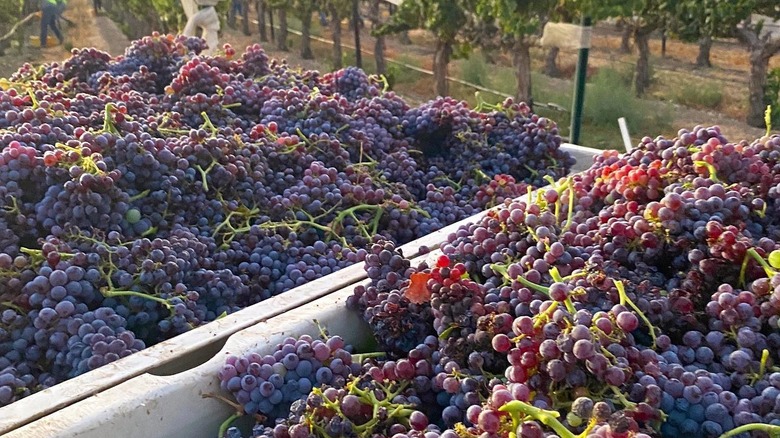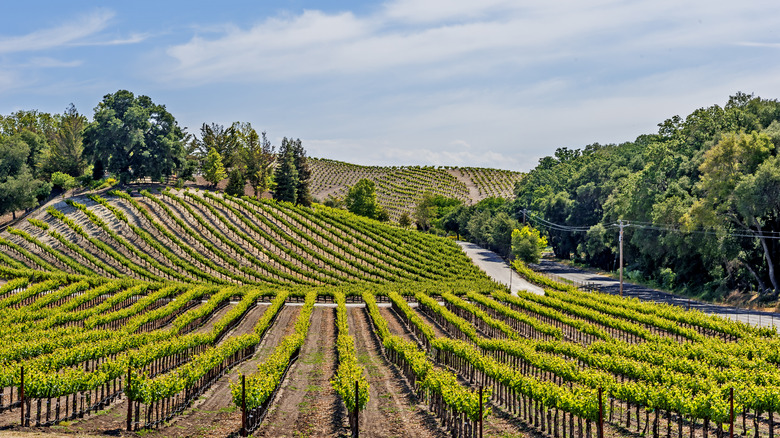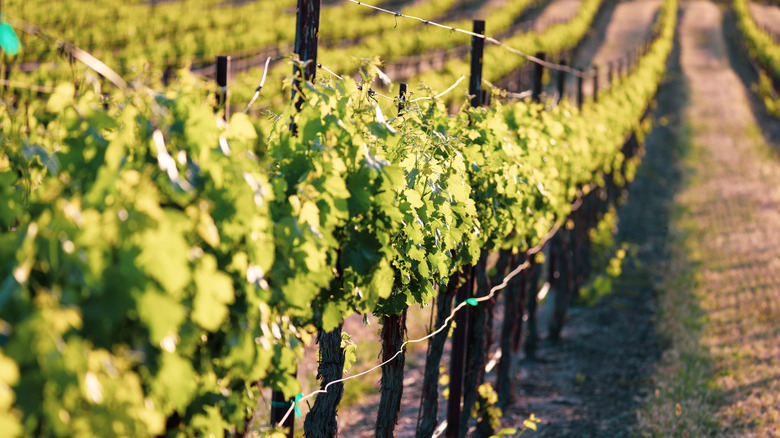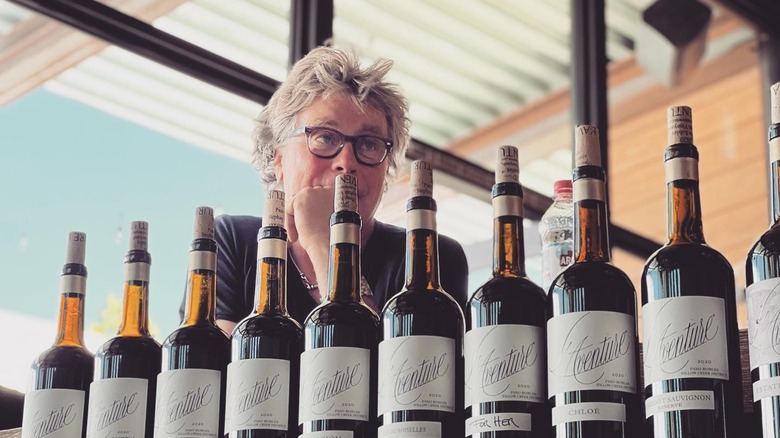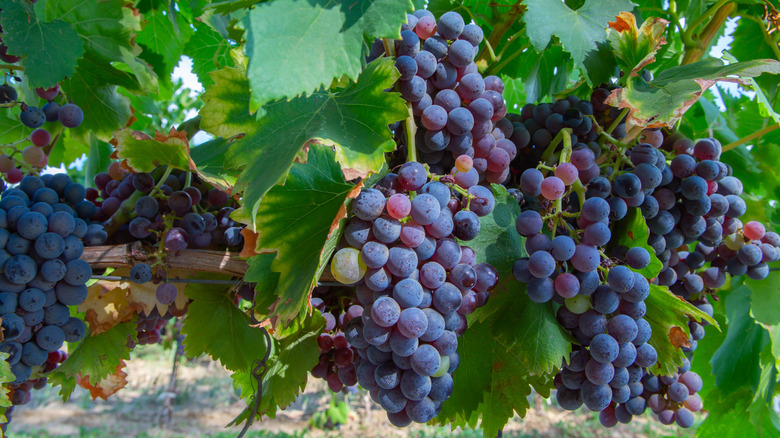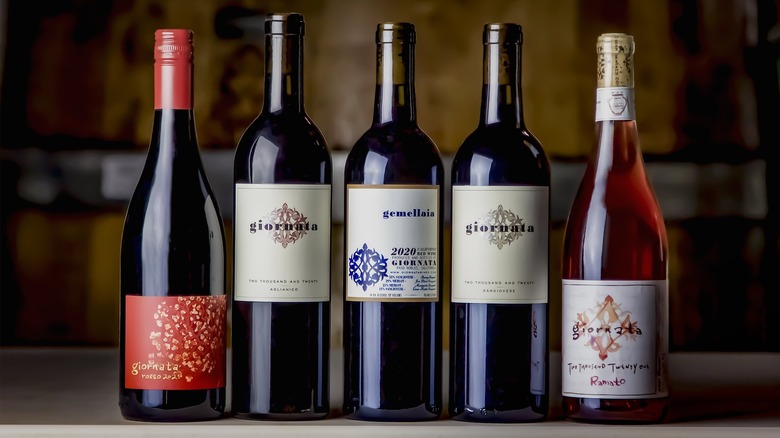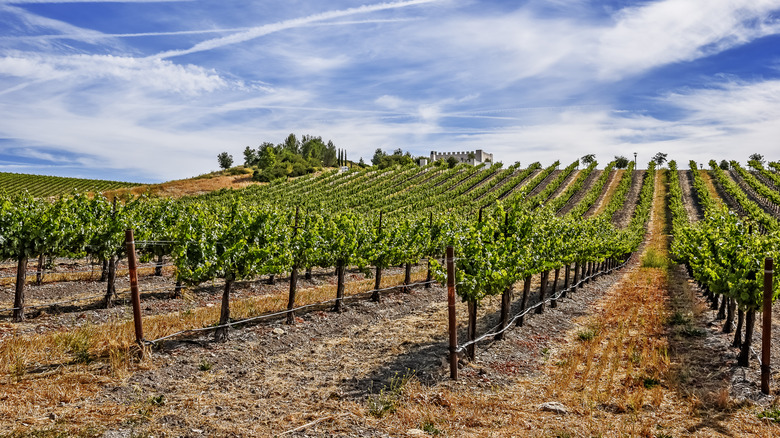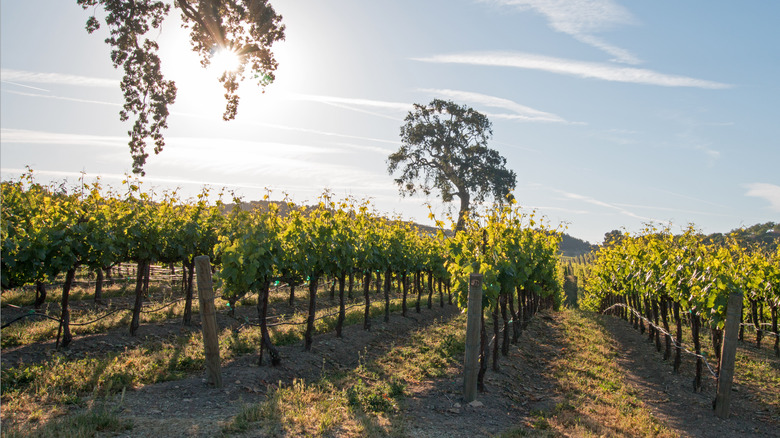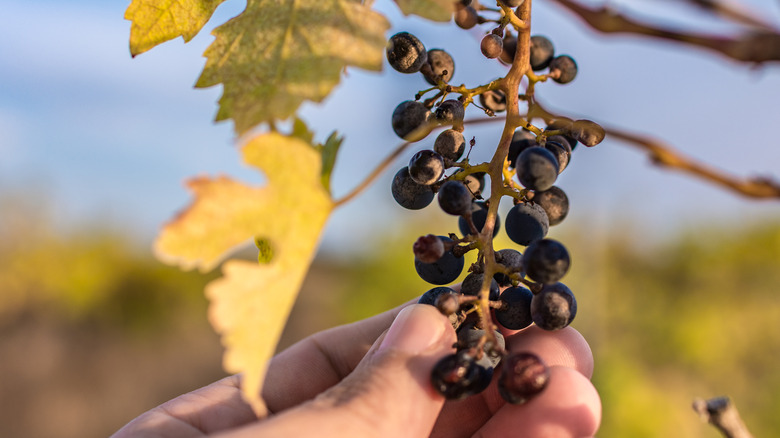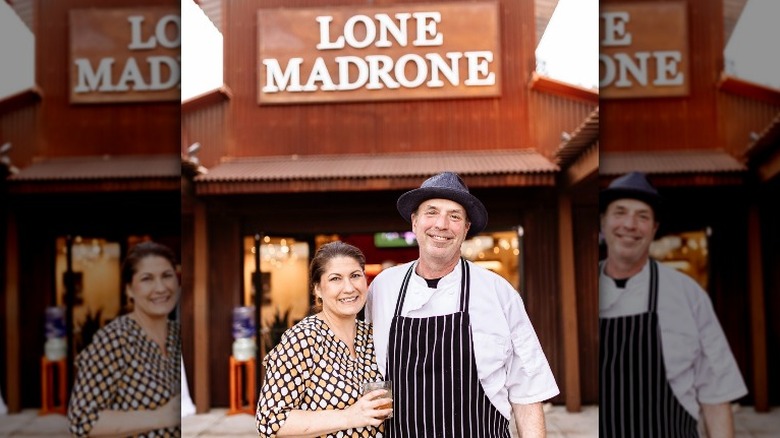The Beginner's Guide To California's Paso Robles Wine
Napa and Sonoma might get the bulk of the attention when it comes to California wines, but that doesn't mean they're the only regions in the state with something to offer. The winemaking region of Paso Robles, located on California's Central Coast, lies between Los Angeles and San Francisco. According to Aaron Mehta, owner of The Wine Press in Boston and Brookline, Massachusetts, warm, sunny days help to ripen the grapes, from cabernet sauvignon to viognier, while the chilly nighttime temps ensure the grapes hold onto their vibrant acidity. And winemakers aren't just making one kind of wines here — there's a surprising amount of diversity in the wines coming out of this region.
Whether you're interested in trying your first-ever Paso wine or you're planning your next trip to the region, it pays to know a bit about Paso Robles before you experience all it has to offer. From Paso's Rhone-style wines to its use of California varietals, there's so much to explore in this underrated wine region.
Paso Robles is famed for its creative winemaking
In some of the world's winemaking regions, including many of the most famous, winemakers are beholden to strict laws that dictate the kind of grapes they can grow and the types of wine they can produce. Deviating from these laws can rob producers of the right to use labeling terms familiar to some wine buyers, so many simply can't afford to branch out and embrace creativity as much as they might want to. But in Paso Robles, creativity is allowed to thrive. "Because the land isn't as valuable, you can experiment more," Aaron Mehta said. "Paso has become a region where you don't have to make what you're supposed to just to keep the shareholder happy."
Stephan Asseo, owner and winemaker at Paso's legendary L'Aventure Winery, decided to leave his established Domaine in Bordeaux, a region dominated by strict AOC laws, specifically to seek a more innovative winemaking path. He found that path in Paso. Winemaker Janell Dusi of J Dusi Wines found the freedom to can one of her premium wines, a zinfandel, with Maker, a practice that's not especially common with higher-quality wines. This kind of creativity is part of what makes Paso such an exciting region, a place where you can expect the unexpected.
Paso boasts 11 AVAs
Paso Robles is its own AVA, or American Viticultural Area, a term used to describe the demarcated grape-growing and wine-producing area of a certain region. But the region as a whole is actually comprised of 11 smaller AVAs with their own unique soils and microclimates. Because of this wide range of climate and soil conditions, there's a significant diversity of the wine you'll find coming out of this region.
Even within Paso's Adelaida District, one of these smaller AVAs, there are noticeable differences between different sites. According to the Paso Robles Wine Country Alliance, cooler portions of the district produce pinot noir, a cooler-climate grape, while just a few miles away, other producers are growing mourvèdre, which generally doesn't ripen until later in the season as it requires significantly more sun and warmth. That kind of diversity means you can experience a wide range of wine styles and profiles within Paso itself. For those who love novelty and are always interested in trying something new, it's the perfect wine region.
The region's weather contributes to such amazing wines
Paso Robles benefits from a Mediterranean climate that boasts exceptionally warm days, which helps varieties like cabernet sauvignon and Mourvèdre ripen. But that doesn't mean the sun is constantly beating down on the region, robbing it of the freshness you're looking for — especially when you're drinking it under the beating sun. According to Wine Folly, Paso has a large diurnal range, meaning that it experiences a significant shift in temperature as it transitions from day to night. In fact, it has the greatest diurnal range of any region in California.
Aaron Mehta says that this temperature swing results in wines with a nice balance of flavors. It's the "best way to get full ripeness in your wine while still maintaining acidity," he said. Of course, you can find plenty of big, bold reds from Paso, a result of the warmer temps. But there are plenty of lighter, more elegant whites and rosés that give this region its stylistic range.
Most are family-owned wineries
If you want a fantastic tasting room experience, many agree that going to a family-owned winery is your best bet. According to Dimensional Insight, family-owned establishments often offer what feels like a more personal experience — you actually get to learn about the family's story and how they got into the wine business and learn about the challenges they've faced along the way. That makes every sip that much more special, especially when you get to meet the people who are working hands-on to bring these wines to fruition.
One of the reasons why Paso Robles is such a special region is the fact that so many of its wineries are family owned. The Paso Robles Wine Country Alliance says that a whopping 95% of its members are privately owned estates. Wine is all about connection and commensality, opening a bottle and sharing it with the table, and finding an excuse to slow down and share our time and energy with people we love. When winemakers go into the business with that kind of vision in mind, you get more than a bottle of wine — you get a story.
Paso Robles is famous for its Rhône blends
You don't have to go all the way to France to experience some amazing Rhône-style blends — they're abundant in Paso Robles, per Wine Folly. For Robert Haas of Tablas Creek Vineyard, the climate of Paso seemed similar to that of Châteauneuf du Pape, a legendary Rhône appellation. By the late '80s, Haas had decided to experiment with Rhône blends, focusing on grapes like mourvédre, grenache, and carignan. It was a success. Other winemakers decided to follow in Haas' footsteps, and now, you can find Rhône-style blends from all over Paso.
And for those who already love the Rhône, these wines are a treat. "I fell in love with Paso for the Rhône-style wines. In a world where everyone could only talk about pinot noir or cabernet, I went for the middle: Give me syrah and grenache all day," Aaron Mehta told us. But it's not just the red blends you should check out — there are plenty of Rhône-style whites coming out of the region as well. "Let's drink more Rhône whites," said Mehta. "A little marsanne, roussanne, and viognier! Let's get some whites with texture."
Paso winemakers produce many Italian grapes
While Rhone-style wines are widely represented in Paso, that doesn't mean they're all the region is known for. In fact, several producers are starting to work with Italian varietals, many of which are generally only found in Italy. According to The Paso Robles Press, the Italian grape sangiovese is particularly popular here, and it can be used for a wide variety of styles. While it's often very bold and tannic, Aaron Mehta said that the grape can sometimes produce "killer chillable reds."
One winery that focuses on Italian grapes is Giornata. Viticulturist Stephy Terrizi, who founded Giornata with her husband, told Paso Robles Press that, "We are not trying to copy what Italians do, but do respect tradition." Their deep, bold, black-fruit-dominated aglianico is an exciting find in California, as is their easy-sipping ramato.
Part of what makes Paso exciting as a region is that you can experience so many different types of wine all at once. After you've indulged in the Rhône styles, you can get a taste of what Italian varietals have to offer as well.
Cabernet sauvignon is king in Paso, but the region offers more than that
Paso Robles produces a lot of cabernets — in fact, it's probably what the region is most well-known for. According to the Paso Robles Wine Country Alliance, cabernet accounts for around 40% of the region's production, and many of the winemakers handling this grape do it justice. "Iron + Sand is making outstanding cabernet that shows a lot of restraint," Aaron Mehta told us. "[Paso] has also become a great region to make cabernet. Some folks take the heat of Paso and make rich, lush cabernet. Other winemakers are showing restraint and are able to produce almost old-world style cabernet."
Despite a wide array of cabs to choose from in Paso, that's definitely not all the region has to offer. Mehta said that people should be more willing to try the whites coming out of this part of California, including marsanne, roussanne, and viognier. They tend to be more full-bodied that colder-climate whites, but many still retain a surprising amount of acidity. So, yes, while you should definitely get your hands on some cab, while you're exploring what Paso has to offer, you shouldn't stop there if you want to get a sense of the range this region is capable of.
It's more affordable than Napa and Sonoma for tourists
Visiting wine country rarely results in a budget trip, but it's undeniable that some areas are more affordable to visit than others. Napa, for example, has gained a reputation as an especially expensive wine region — from the food to the wine to the accommodations, you have to be willing to spend if you take a trip there (or even just purchase the region's premium wines). Sonoma, while somewhat more affordable, can still be pricey. But Paso is gaining attention as a more affordable region, both for its wine and tourism.
According to Aaron Mehta, this difference in price is largely due to the fact that land is just more expensive in Napa and Sonoma than it is in Paso, "The more expensive the land, the more you can demand for the cost of fruit," he said. "I have found that prices for wine from Napa and Sonoma have driven folks to seek alternatives from Paso. A lot of people start in Paso for the pricing but keep exploring wines from that area because they are so good!"
Paso wine growers are already seeing the effects of climate change
Like all agricultural workers, winemakers across the world are considering their futures in light of the obvious signs of climate change. For many producers, the answer is planting more heat- and drought-resistant grape varieties. But in a climate that's already as warm as Paso Robles, there is undoubtedly some nervousness about how to move forward into a climate that might look much different than it did 10 to 20 years ago. In fact, NPR reported that the region is anticipating potentially catastrophic climate patterns, resulting in significant droughts that could have a drastic effect on the industry.
But considering the region's varied microclimates, some vineyards will probably do fine in the upcoming years, while others may struggle more. It's not a problem specific to Paso, though — Climate Central expects a noticeable shift in wine production throughout the world. The challenge for winemakers is how to farm sustainably while still producing top-quality wines that people are excited to drink. But since Paso is already known for its innovative winemaking, it seems well-primed to survive in a less-than-conventional future.
There are incredible restaurants
Where there's good wine, there should also be good food. Luckily, Paso Robles doesn't disappoint on that front. If you're visiting the area, there are plenty of excellent restaurants to check out, some of which are actually at the wineries themselves. If you stop by the Lone Madrone tasting room, you have to be sure to eat at Kitchen Forty Six, which serves dishes that are perfectly paired with the wines. Calcareous Vineyard also boasts a top-notch menu at its tasting room — eat outside and enjoy the breathtaking view of the vineyards below.
In town, La Cosecha is the place to go for Latin-inspired food, including seafood and meat paella that will blow your mind. The trendy in bloom also serves up incredible family-style fare, and, since it's opened, it's functioned as a meeting place for some wine industry professionals looking for a fun night out. You can order wine, of course, but there's also a fun cocktail program if you need a break from the juice.
Tin City has many tasting rooms and wine-centric experiences
Those planning a trip to Paso Robles to explore the region's wine scene will naturally be hopping from winery to winery, but you shouldn't limit yourself — there's so much to do in the area. One fun spot to check out is Tin City, a maker's market full of a variety of shops, restaurants, and tasting rooms to explore. This is a particularly fun spot because it's all walkable, so you don't have to worry about driving to the next stop. Some notable spots to check out are Hubba Wines, which is churning out some fun and creative bottles, as well as Field Recordings, which Aaron Mehta said is producing "very well-made wines."
But even non-wine drinkers will find plenty to enjoy in Tin City. BarrelHouse Brewing Co. is the place to go when you're tired of sipping wine and your palate is in need of something different. Olivas de Oro, a store offering artisan olive oils and vinegar, is a fun place to shop when you need a break from drinking altogether. And Negranti Creamery has the fix your sweet tooth is begging for — sheep's milk ice cream is totally worth a try. With all of these different offerings, Tin City is a must-stop spot on any Paso Robles wine tour.

